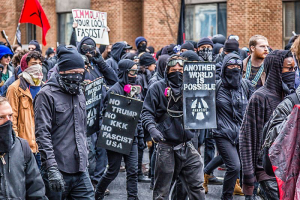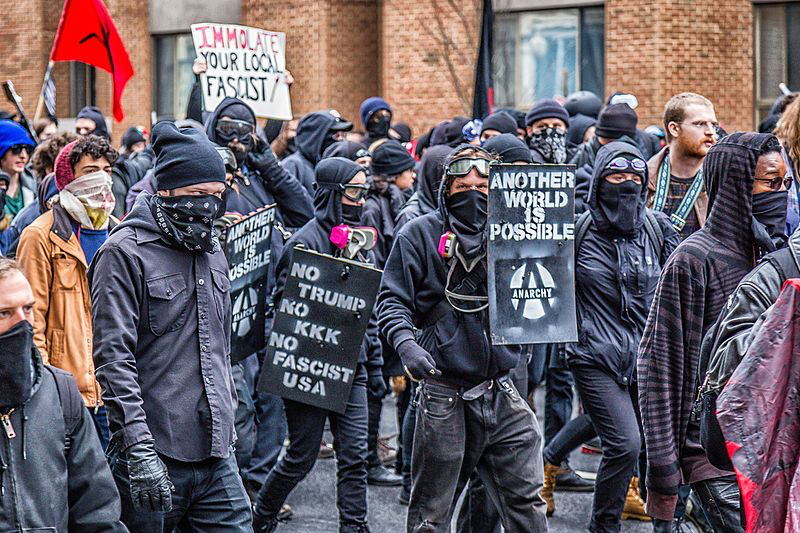
This past Saturday I drove down to the local gun store in my quaint mountain town to pick up some bismuth shells, just in time for an early morning Sunday hunt. As I perused the impressive selection of bird bashers, a small fracas in my periphery began rising to a twangy crescendo. I rounded a rack of turkey calls to investigate, and found a few grizzled local woodsmen huddled around a fuzzy monitor bolted to the ceiling, barking the ghostly specter of Sean Hannity through its pixelated display. The men stirred.
“Paid Protesters!” One grumbled.
“George Soros!” Exclaimed another.
Arguments against the state were shelved more often than not in favor of presentations on a seemingly endless parade of ‘passive’ social injustices.
I winced and felt the hot flush of embarrassment creep across my face as the screen danced with black-clad anarchists, gleefully smashing windows and tossing trash cans. Overpowered with nostalgia, I thought back to the sparse coffee shops and dimly-lit dish pits where my comrades and I would plot our insidious coups, against the oppression of plate glass windows and aluminum trash cans, and couldn’t help but laugh at the idea that global billionaires were somehow tugging on the puppet strings. I’m afraid the truth is far more desperate.
I spent nearly a decade of my young life in ‘hard’ left movements. I spent my teens printing zines, organizing, squatting, and worshipping the ironically “bourgeois” intelligentsia that pandered to our leftist sensibilities. At the core of my ideology was a burning desire for liberty and an intense distrust of the state. In the beginning, I might saunter into the local cooperative and find an impassioned debate over the legitimacy of insurrectionary movements abroad, or the most practical way to pirate electricity without being discovered. Over time, the fiery rhetoric became dogma, penetrating my psyche right down to its id. I saw the state’s oppression in everything and everyone. I noticed behavioral patterns of violence and subjugation that seemed to reproduce to infinity. And through this new countenance, the changing face of leftism was obscured to me.
The New Social Justice
Social Justice was always a welcome addendum to anti-statist leftism for me. I gladly assumed the mantle and answered the call to march for police accountability, for women’s rights, for the ethical treatment of gays. The concept of ‘intersectional Social Justice’ was then a contentious one among many left-wing radicals, seen by many as a willful distraction from the core anti-statist message of our ideology, and worthy of only a small devotion. To focus too heavily on social issues was said to the be the resting place of sleepy liberals. And liberals, perhaps even as much as skinheads or the police, were the bane of the radical left. They meant to co-opt our movement and reacquaint us with their ineffective and self-aggrandizing brand of sedition and hoped to lasso a few of us back into the electoral process (abstaining from which was radical dharma at the time). They were, in short, a generally unwelcome addition to our ranks, and would usually turn their backs at the first mention of truly anti-statist politik.
I had more exposure than most to the left-wing radical “scene,” as it were, traveling to convergence spaces and conferences, worker-owned collectives and the like. I noticed a shift in the demographic makeup of the movement that became more pronounced with time. Character archetypes abound in the radical sphere, from crusty professors to dreadlocked primitivists, (and that leftist holy grail, the disaffected executive, living, perhaps, in a yurt or some otherwise subversive structure on some land that probably doesn’t belong to him), became more and more sparse. There was a new contingent of leftists, a new archetype that had seemingly appeared out of nowhere. (The radical space was not exactly adept at coalition-building, keep in mind). These new figures were polished, soft-speaking, and shied away from the hardline agitprop of resistance. Gone were the ‘zines adorned with flaming police cars, replaced by new editorials that opined the importance of gender fluidity and other obtuse concepts. A new language began to congeal, an especially elitist dialectic that almost required translation to English.
The left was consumed by this new drive to expose the innate bigotry of the majority.
The new language was accompanied by new tactics. Affinity meetings that were once hotbeds of dissent began to seem more like kangaroo courts. Arguments began to spring from the nascent well of discontent, and “accountability” hearings were the new norm, a process more often than not designed to elucidate the accused’s latent homophobia or racism. Arguments against the state were shelved more often than not in favor of presentations on a seemingly endless parade of ‘passive’ social injustices.
The old radical paradigm, in rudiment, went like this: “America was founded upon slavery, therefore America is racist, We are here because we disagree with racism.” The implied understanding was that because we had all found each other through our mutual disgust with what we had determined was a racist system that unfairly penalized minority populations, then we had already rejected a racist worldview. Thus our deliverance and rebirth occurred. It was understood to be innate to our shared ideology, and therefore our collective will could be focused and our mutual intent had been decided. This formed the basis for an arguably unified front that could be assembled and directed at will. But this mutual understanding was being corroded by a new, pernicious force that had infested every corner of the space. Anti-fascist organizers were no longer satisfied by directing their ire towards governmental institutions or hate groups and instead turned the looking glass inward. The toxic rancor of racism was found in our own ranks, by God!
Racism was found by the New Left to be inherent in all “whites.” (Racism is now said in the left to be a confluence of power and bigotry. Minorities, lacking the key ingredient of power, are exempt from this distinction.) Cis-gendered people (those of us who identify with our birth sex) were asked to “make space” for those that were not. Special privileges to be heard were conferred to the most oppressed within the group. This led to a bizarre new struggle within the movement over who might lay claim to being the most truly oppressed. The left was consumed by this new drive to expose the innate bigotry of the majority, especially within our own sphere. Where activists were once excommunicated over allegations of collusion with the authorities, they were now cast out frequently by accusations of complacent prejudice.
Friend and Foe in the New Left
Truth be told, I do not disagree with many of these indictments of mainstream culture. Inequities are certainly rampant in our society and must be illustrated and corrected. But the new face of the radical left seemed to be devouring itself. Where we had once in unison identified the state as the malevolent genesis of our oppression, our peers were now the true oppressors. The state apparently had not been oppressing us nearly as much as we had been oppressing one another. Anecdote became empirical, and experiences became the radical eucharist. Personal accounts of bigotry were now to be equivalent to universal and incontrovertible truth. A culture of martyrdom arose wherein victimhood was conflated with benevolence.
The left has lost its traction by alienating average people.
In the time before this new left, the directive was crystal clear: to illustrate the oppression of the state as it occurs to most everyone in the country, in the form of endemic poverty, uncorrected sickness, bankrupt free trade agreements, and the formation of a global police state. Organizers could mobilize radicals en masse to demonstrate against these societal evils, recalling the controlled chaos of the Seattle WTO demonstrations, or the significant uprising in Miami against the FTAA in 2003. The scene had now become almost entirely disjointed, and the former amalgamation of radicals ceased to exist. The radical left had become an especially tiresome arm of the progressive centrists, now content to lobby the state for greater societal controls rather than demand its abolishment.
There was only a small faction of anti-statist minded radicals left in the fray, and it was in them (and me) that the responsibility to carry on the tradition of rejecting the state and fighting for liberty. Instead, they clung to the antique tactics of property destruction and rock-tossing. The problem being, these tactics were complementary ones, meant only to supplement a coherent and organized radical left movement that had ceased to exist. They were to be an organ of outrage designed to counterbalance a cogent and heady vanguard of intellectual radicals. These radicals have become dinosaurs, defecting for the higher moral ground of the new left lest they fall victim to the witch hunt.
A Wayward Movement
The left has lost its traction by alienating average people and turning its intent towards social issues that are codified for inclusion. And of course, their argument is no longer to abolish the state, but to beg for benevolence at the feet of a corrupt government. I could not fathom how a group of people could move in a linear fashion from the idea that the central state was incorrigibly corrupt to the notion that we could somehow force it to provide for our interests. In a time of endemic poverty, I could no longer bear the guilt of selfishly aligning myself with a movement that seemed less concerned with exposing a secret war in the Middle East than it was with exposing my friends and peers as patriarchal villains.
In my last dark days with the left, I pleaded for objectivity, reason, rationale. These requests fell on deaf ears and nearly always resulted in a collective tongue lashing against my perceived ignorance. Why, they demanded, could I not accept that my perspective was being undermined by my ‘whiteness’? Why, if I was so committed to change and righteousness, could I not separate the evil archonic male desire from my true self? My positions, they would argue, had become tainted, infected by my hetero-ness, my maleness, my caucasian-ness. The whole world was a giant quagmire.
It occurs to me from time to time, usually in the throes of insomnia, that the state may have supplanted these contentious narratives within the space to misdirect and discredit the radical left, although this possibility has ceased to be relevant. The sad truth to behold is that the last actors in the space took to the streets to smash Starbucks’ windows and foolishly posture when they should have been pleading with their peers to reconsider a truly anti-statist perspective. In a last hurrah of hedonistic self-satisfaction, they have delivered the final blow to the radical left.

Evan Stern
Evan Stern is an American Entrepreneur from Providence, Rhode Island. He has worked internationally with currency experts and economists to develop new methods of value exchange and is a vocal proponent of the complementary currency movement.
This article was originally published on FEE.org. Read the original article.
